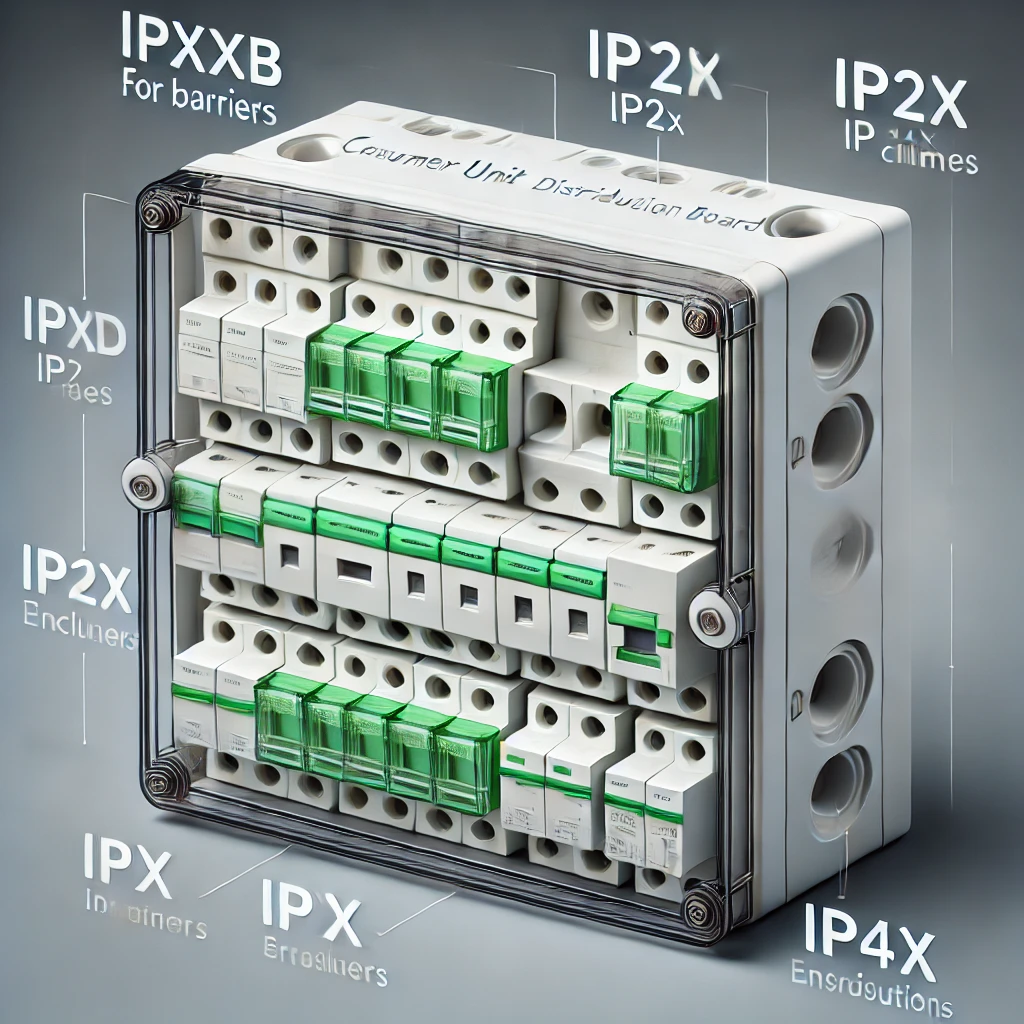How Should Barriers or Enclosures with IP Ratings Be Used to Protect Against Contact with Live Parts in a Fusebox Unit (AKA Consumer Unit or Distribution Board)?
Regulation 416.2 of BS 7671 specifies the use of barriers or enclosures with IP ratings to protect against accidental contact with live parts in electrical installations, particularly within fusebox units (consumer units or distribution boards). These measures ensure that live parts remain inaccessible, preventing electrical hazards.

OW London Electrician and Home Automation Engineers Team
How Should Barriers or Enclosures with IP Ratings Be Used to Protect Against Contact with Live Parts in a Fusebox Unit (AKA Consumer Unit or Distribution Board)?
In electrical installations, ensuring that live parts are not accidentally touched is a critical safety requirement. This is particularly important in areas like fusebox units (also known as consumer units or distribution boards), where many live parts are present. To prevent accidental contact, barriers or enclosures with specific IP ratings are used to shield live parts, making sure that they remain inaccessible to unauthorized individuals or inadvertent contact.
Regulation 416.2 – Barriers or enclosures with IP ratings are intended to prevent contact with live parts.
Regulation 416.2.1 states:
"Live parts shall be inside enclosures or behind barriers providing at least the degree of protection IPXXB or IP2X except that, where larger openings occur during the replacement of parts, such as certain lampholders or fuses, or where larger openings are necessary to allow the proper functioning of equipment according to the relevant requirements for the equipment:
- (i) Suitable precautions shall be taken to prevent persons or livestock from unintentionally touching live parts, and
- (ii) As far as is reasonably practicable, persons will be aware that live parts can be touched through the opening and should not be touched intentionally, and
- (iii) The opening shall be as small as is consistent with the requirement for proper functioning and for replacement of a part."
Regulation 416.2.2 states:
"A horizontal top surface of a barrier or enclosure which is readily accessible shall provide a degree of protection of at least IPXXD or IP4X."
Regulation 416.2.3 states:
"A barrier or enclosure shall be firmly secured in place and have sufficient stability and durability to maintain the required degree of protection and appropriate separation from live parts in the known conditions of normal service, taking account of relevant external influences."
Regulation 416.2.4 states:
"Where it is necessary to remove a barrier or open an enclosure or remove parts of enclosures, this shall be possible only:
- (i) By the use of a key or tool, or
- (ii) After disconnection of the supply to live parts against which the barriers or enclosures afford protection, restoration of the supply being possible only after replacement or reclosure of the barrier or enclosure, or
- (iii) Where an intermediate barrier providing a degree of protection of at least IPXXB or IP2X prevents contact with live parts, by the use of a key or tool to remove the intermediate barrier."
NOTE: This regulation does not apply to:
- A ceiling rose complying with BS 67
- A cord operated switch complying with BS EN 60669-1
- A bayonet lampholder complying with BS EN 61184
- An Edison screw lampholder complying with BS EN 60238.
Simplified Explanation:
These regulations ensure that live parts within electrical installations, including fusebox units (aka consumer units or distribution boards), are adequately protected to prevent accidental contact. Here’s a breakdown of what these regulations mean:
Regulation 416.2.1:
- Inside the Fusebox Unit (Consumer Unit or Distribution Board): Live parts, such as those within a fusebox unit, must be enclosed or behind barriers that provide at least IPXXB or IP2X protection. These ratings ensure that even small objects, like fingers, cannot reach the live parts.
- During Replacement or Maintenance: When parts like fuses or lampholders are replaced, openings may temporarily expose live parts. In such cases:
- Precautions should be taken to prevent accidental contact.
- People should be made aware that the live parts can be touched, and they should avoid intentional contact.
- The size of any openings should be minimized while allowing the necessary work to be done.
Regulation 416.2.2:
- Top Surfaces of Enclosures: If a horizontal top surface of a barrier or enclosure in a fusebox unit (aka consumer unit or distribution board) is readily accessible, it must provide a higher level of protection, at least IPXXD or IP4X. This prevents larger objects from falling into the enclosure and making contact with live parts.
Regulation 416.2.3:
- Stability and Durability: The barriers or enclosures in fusebox units must be firmly secured and stable enough to maintain protection throughout their service life, even in the face of external influences like vibration or impact.
Regulation 416.2.4:
- Removing Barriers in a Fusebox Unit (Consumer Unit or Distribution Board): If you need to remove a barrier or open an enclosure in a fusebox unit:
- This should only be possible with a key or tool.
- Alternatively, the power supply to the live parts must be disconnected first, and re-energizing should only be possible after the barrier or enclosure is replaced or closed.
- If there is an intermediate barrier providing at least IPXXB or IP2X protection, it can only be removed with a key or tool.
Frequently Asked Questions
Q: Why must live parts in a fusebox unit (aka consumer unit or distribution board) be enclosed or behind barriers with IP ratings?
A: Live parts must be enclosed or behind barriers with appropriate IP ratings to prevent accidental contact, which could lead to electric shock or other electrical hazards. The enclosures with IP ratings, such as IPXXB or IP2X, ensure that live parts remain inaccessible, especially to non-qualified individuals, as per Regulation 416.2.
Q: What does IPXXB or IP2X protection mean for a fusebox unit (consumer unit or distribution board)?
A: IPXXB and IP2X are protection ratings that specify how well an enclosure can prevent access to hazardous parts. These ratings ensure that fingers or other small objects cannot make contact with live parts inside the fusebox unit, consumer unit, or distribution board, as required by Regulation 416.2.1.
Q: Can the barriers or enclosures with IP ratings in a fusebox unit (consumer unit or distribution board) be easily removed?
A: No, barriers or enclosures should only be removable using a key or tool, or after disconnecting the power supply, according to Regulation 416.2.4. This prevents unauthorized or accidental removal, which could expose live parts.
Q: Why is a higher IP protection rating required for the top surfaces of enclosures in a fusebox unit (consumer unit or distribution board)?
A: The top surfaces of enclosures, such as those on a fusebox unit, consumer unit, or distribution board, may be more prone to objects falling onto them. A higher IP protection rating, like IPXXD or IP4X, ensures that even larger objects cannot penetrate the enclosure and contact live parts, as outlined in Regulation 416.2.2.
Q: What precautions should be taken during maintenance or replacement of parts in a fusebox unit (consumer unit or distribution board)?
A: During maintenance or replacement of parts, it’s important to minimize exposure to live parts and ensure that people are aware of the potential risk, as per Regulation 416.2.1. Openings should be kept as small as possible, and necessary precautions must be in place to prevent accidental contact.

What users Saying
Discover what our customers think about our services. Their feedback reflects our commitment to delivering exceptional service and expert solutions for all electrical and security needs.

